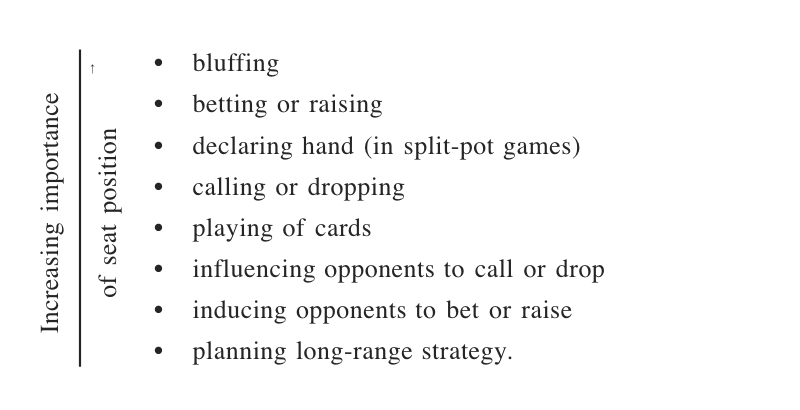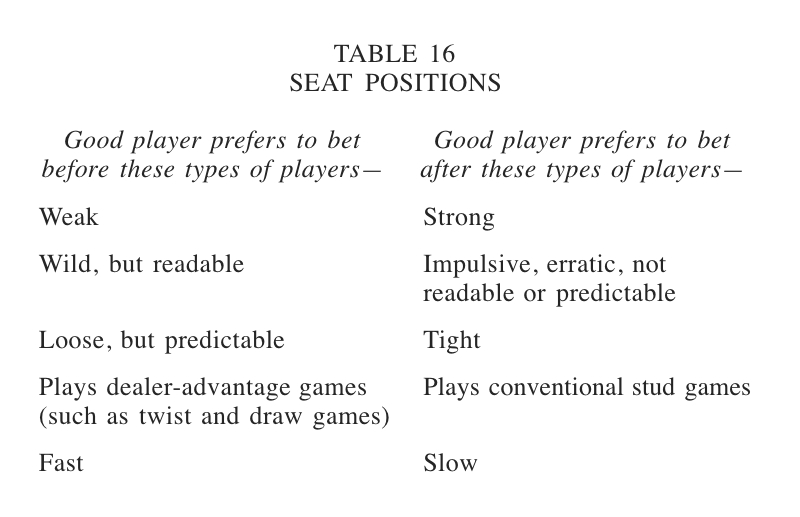Situation and Position
3. Situation and Position
Action strategy depends on the immediate situation and involves decisions about calling, opening, betting, raising, dropping, and bluffing. In making those decisions, the good player correlates the following poker variables to the immediate situation.
- Estimated strength15 and statistical value16 of his own hand
- Game
- pace
- temperament
- atmosphere
- time (such as first hand, a late hour, last hand)
- size of pot
- potential size of pot
- Opponents
- indicated strength
- attitude
- attentiveness
- win or loss status
- effect of previous bet
- Position
- fundamental
- technical
_______________________
15 Estimated strength of a hand is relative to the estimated strengths of opponents’ hands.
_______________________
16 Statistical value of a hand is relative to the number of opponents. The statistical value of a hand decreases with increasing number of opponents.
The good player appraises his situation from both a fundamental and a technical position. His fundamental position is the estimated strength and statistical value of his hand relative to other players. His technical position is the strategic and psychological advantage he holds over his opponents at a given moment. An important strategical consideration is seat position.
Seat position is important in nearly every decision. The good player adjusts his strategy according to his seat position relative to the dealer, opener, bettor, raiser, and the strong and weak hands. He considers his seat position in decisions about—

The best seat position depends on where the other players sit. The next anecdote about John Finn shows why the good player likes to position himself as shown in Table 16.

The good player usually gets a desirable seat at the start of a game because his opponents seldom care where they sit. If an opponent is conscious of position, he generally tries to sit behind (bet after) the loosest or wildest player—the opposite position sought by the good player. A player can often pick a good position by arriving after the players are seated and then squeezing into the best seat position. (But continuous late arrival can hurt a game.) The good player can also use the excuse of “changing his luck” to swap seats with a player in a better seat position. That ploy also gives his opponents the erroneous but advantageous impression that he is superstitious.
The dealer has an advantage in hold’em, draw, or any form of closed-hand poker in which he bets last. When the same person always deals (e.g., a house dealer), that advantage is evenly distributed by using a marker, a button, or a buck that passes in turn to each player. Usually the player with the marker bets first, and the player to the right of marker bets last, as would a dealer.
Most regular players get into a habit of sitting in the same position. In the Monday night game, John quietly arranges the seating to his advantage, and then game after game the players sit approximately in the same positions. He maintains this arrangement by preventing the players from realizing that they keep sitting in positions favorable to him.
Ted Fehr’s betting is wild, and impulsive. While John can usually read Ted’s hands, he can seldom predict his betting actions. By positioning himself so Ted bets first, John can adjust his strategy according to Ted’s play. Sid Bennett’s betting is even wilder, but is predictable. By betting before him, John can often check his strong hands and let Sid do the betting for him. It makes less difference to John where Quintin (a sound player) or Scotty (a tight player) sit. The ideal seating arrangement for John is illustrated below:
